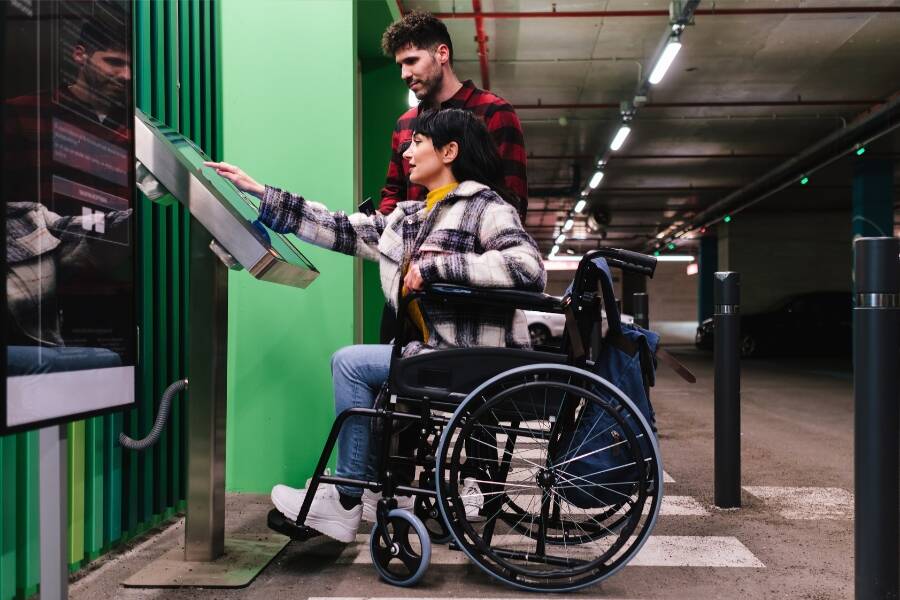Kiosks are now part of everyday life—you see them at multiple locations like fast food spots when ordering a meal, ATMs when grabbing cash, or airports during check-in. They’ve made things quicker and more convenient for people on the go while also helping businesses run more efficiently by easing the demand for staff.
However, these devices can be frustrating for individuals with disabilities, particularly those who are blind or have reduced eyesight, leading to a poor visitor experience. According to a 2024 study by Vispero and TPGi, 58% of blind and low-vision respondents have had negative restaurant experiences, mainly due to inaccessible kiosks and payment systems, which made it difficult for them to order food confidently.
Since its passage in 1990, the Americans with Disabilities Act (ADA) has played a key role in protecting the rights of people with impairments. It facilitates equal access and usage of public spaces, services, and opportunities for individuals with physical disabilities, including those with mobility challenges and hearing and vision impairments, parallel to those without such impairments.
As more organizations and public entities utilize kiosks and virtual front desk solutions to connect with customers, here are a few practical, approachable ways to ensure your kiosks are welcoming and accessible to all customers:
1. Place Your Kiosk In A Location With Accessibility In Mind
The Disability Act requires all public-facing technology to be accessible to people with disabilities. This applies to solutions, such as video receptionist platforms, which should be designed with physical accessibility in mind. This implies:
- Clear and Simple Layout: Kiosk interfaces should have intuitive navigation, prominent buttons, and an easy-to-read font. Avoid clutter or overly complex menus. A clean, simple design helps all users, but it is especially essential for individuals with cognitive difficulties or learning challenges. The goal is to make the experience as stress-free and intuitive as possible.
2. Enhance Accessibility with Audio and Visual Features
The ADA requires that people with hearing and vision impairments be able to engage with kiosks effectively. Here’s how you can make your kiosk inclusive.
- Audio Feedback: For low-vision customers, being able to hear what’s happening on the screen is crucial. Kiosks should offer spoken instructions or sound cues through built-in speakers. Audio guidance helps users move through the process without needing to see everything clearly. This enables them to complete tasks with confidence.
- Visual Enhancements: Visual accessibility isn’t one-size-fits-all. Some people benefit from large text, bold fonts, or high-contrast color schemes that make things easier to see. Others might rely on visual cues, such as blinking text, outlined buttons, or easily recognizable icons—especially if they have cognitive disabilities or learning differences. It’s about designing the interface so that it not only looks nice but also works effectively for people with a range of visual and cognitive needs.
- Live Virtual Assistant: Adding a live virtual assistant to your kiosk can provide real-time help for users who might need extra support. This feature allows someone on the other end to guide users through the process via video or audio chat, making the experience smoother for people with various disabilities. It’s especially useful for those who may struggle with technology or need personalized assistance that audio or visual features alone can’t fully provide.
3. Offer Flexible Input Methods
To accommodate people with diverse disabilities, kiosks should accept a variety of input methods. While touchscreens are standard, they are not the sole means by which users interact with the system. Consider:
- Keypads or Alternative Controls: Not everyone can use a touchscreen, so providing a tactile option, such as a keypad or a joystick-style control, gives users an alternative way to navigate. It’s also a reliable backup if the touchscreen fails.
- Remote Live Assistance: For individuals with limited hand mobility or other touchscreen-related challenges, receiving help from a trained and qualified person can make all the difference. They can navigate screens, make selections, and assist with tasks remotely. This type of support makes kiosks more inclusive and less frustrating, allowing users to get help without needing physical contact while maintaining their sense of independence and privacy.
4. Ensure User-Friendly Interactions
The ADA encourages businesses to make public spaces accessible to everyone. One way to support that is by keeping kiosk interactions straightforward and minimizing errors. Here are a few ways to help with that:
- Clear Instructions: The kiosk should walk users through each step without overwhelming them. Instruction should be simple, direct, and jargon-free, provided in written and audio modes. Any audio or video content should have captions or transcripts for customers who are deaf or hard of hearing.
- Error Handling: Mistakes are going to happen. What matters is how the kiosk responds. If something goes wrong, the kiosk should inform the user clearly and calmly immediately. More importantly, it should show them how to fix the issue step by step. This thoughtful response keeps the experience from becoming frustrating and helps users feel capable and in control, even when things don’t go perfectly.
Why Designing Accessible Kiosks Matter
Making kiosks easy to use for everyone goes beyond just following the rules. It’s about showing respect and creating an inclusive space where all customers feel welcome and valued. Designing with ADA standards in mind helps ensure no one is left out or frustrated.
Originally designed with physical therapy clinics in mind, WelcomeWare offers a uniquely accessible solution. Combining a virtual receptionist kiosk, virtual front desk software, and video reception technology, WelcomeWare ensures that every visitor has a welcoming, supportive experience.

